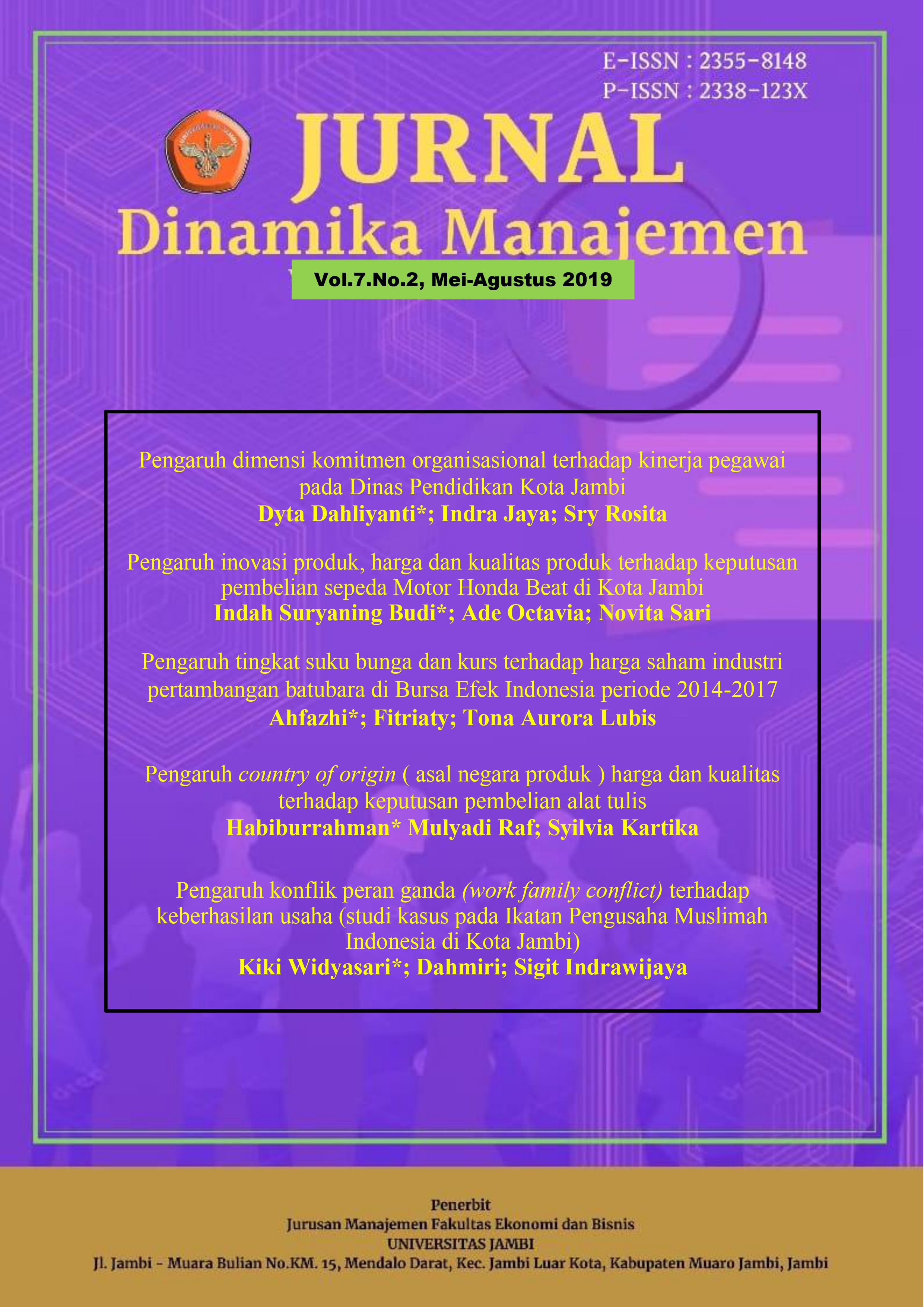Pengaruh dimensi komitmen organisasional terhadap kinerja pegawai pada Dinas Pendidikan Kota Jambi
Keywords:
affective commitment, continuance, employee performanceAbstract
The purpose of this study was to reveal the influence of the dimensions of affective commitment, continuance commitment, and normative commitment on employee performance. The research method used in this research is the survey method, while data collection techniques are carried out through questionnaires. The population in this study were all civil servants at the Jambi City Education Office. A sample of 60 respondents. The analytical tool used in this study consists of validity and reliability testing, multiple linear regression analysis, t-test, F test, and determination test coefficient test. The entire investigation was calculated using the SPSS version 17.00 program. Research shows that the dimensions of affective commitment, continuance commitment, and normative commitment simultaneously have a positive and significant effect on employee performance. While partially variables that influence employee performance, practical dedication, continuance commitment, and normative commitment. Furthermore, from the three influential dimensions, the dimension of continuance commitment has the most dominant influence.
Downloads
References
Allen J, Natalie & Meyer, John P. (1993). Commitment to organizational and occupations: extention and test of three-component conceptualization
Amirul Akbar, Mochammad A.M. dan Mochammad . (2017). Pengaruh komitmen organisasional terhadap kinerja (studi pada karyawan PT Pelindo Surabaya).
Jurnal Administrasi Bisnis (JAB), 47(2).
Colquitt, Jason A, Jeffery A Lepine dan Michael J. Wesson. (2015). Organizational behaviour: improving performance and commitment in the workplace. Fourth Edition: Texas A&M University.
Fahmi, Irham. (2015). Manajemen kinerja: teori dan aplikasi. Bandung: Alfabeta.
Ghozali, Imam. (2009). Aplikasi analisis multivariate dengan program SPSS. Edisi Keempat, Semarang: Universitas Diponegoro.
Ghozali, Imam. (2011). Aplikasi analisis multivariate dengan program SPSS. Edisi 4. Semarang: UNDIP.
Indriantoro, Nur dan Supomo. (2014). Metodologi penelitian bisnis untuk akuntansi dan manajemen.Yogyakarta: BPFE.
Luthans, fred. (2006). Prilaku organisasi. Yogyakarta: Andi.
Mathis, Robert L dan John H Jackson. (2011). Human resource management, Terjemahan, Edisi Kesepuluh, Jakarta: Salemba Empat.
Moeheriono. (2014). Pengukuran kinerja berbasis kompetensi, Edisi Revisi. Jakarta: Rajawali Pers.
Nurandini, Arina. (2014). Analisis pengaruh komitmen organisasi terhadap kinerja karyawan(studi pada Pegawai Perum Perumnas Jakarta), Jurnal Studi Manajemen & Organisasi, 11(1), 78 - 91.
Sapitri, Ranty. (2016). Pengaruh komitmen organisasi terhadap kinerja karyawan perusahaan listrik negara area pekanbaru, JOM Fisip, 3(2).
Sedarmayanti. (2014). Sumber daya manusia dan produktivitas kerja. Bandung: CV. Mandar Maju.
Sekaran, Uma. (2006). Metodologi penelitian untuk bisnis, Edisi 4, Buku 1 dan buku 2, Jakarta: Salemba Empat.
Sopiah. (2008). Perilaku organisasional. Yogyakarta: Andi Offset.
Sugiyono. (2012). Metode penelitian kuantitatif dan R & D. Bandung: Alfabeta.
Sunyoto, Danang. (2011). Dasar-dasar manajemen sumber daya manusia. Jakarta: Caps Publishing.
S Sunargo, D Hastuti. (2019).Mengatasi perilaku kerja kontraproduktif melalui peran integratif politik organisasional dan kecerdasan emosional pada era revolusi industri 4.0, Jurnal Paradigma Ekonomika 14 (2), 45-54
Wirawan. (2014). Kepemimpinan: teori, psikologi, perilaku organisasi, aplikasi dan penelitian. Jakarta: PT Rajagrafindo Persada.
Downloads
Published
How to Cite
Issue
Section
License
Copyright (c) 2019 Dyta Dahliyanti, Indra Jaya, Sry Rosita

This work is licensed under a Creative Commons Attribution-ShareAlike 4.0 International License.




